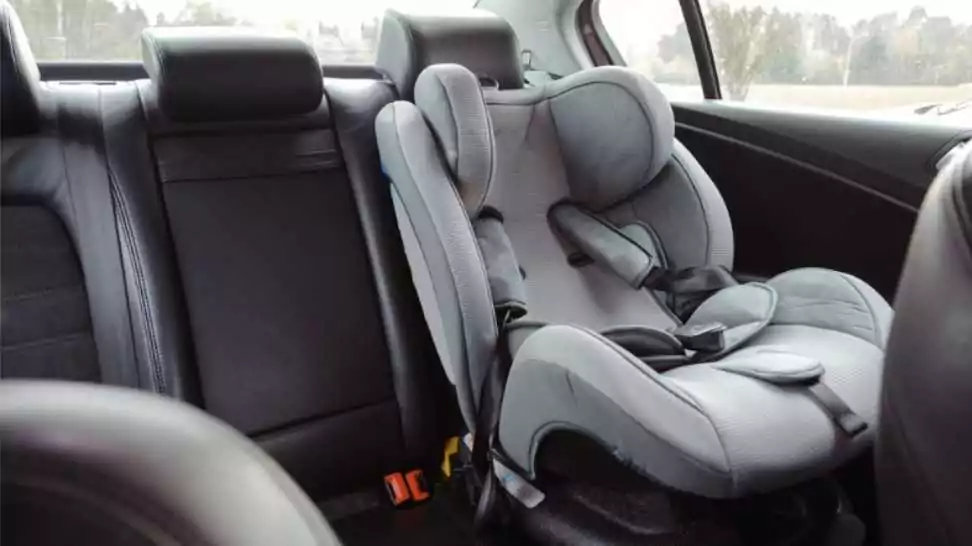How Long Do Infant Car Seats Last?

Every parent wants to ensure the utmost safety for their child, especially when it comes to traveling. Infant car seats are a non-negotiable necessity in this journey, providing vital protection for the youngest passengers during car rides. But how long do these car seats last? What safety standards should they meet? This is not just about comfort – it’s a critical safety issue.
In this blog, we aim to educate and guide parents on how long do infant car seats last. We’ll delve into why these seats are essential, how long they can be used, and what safety standards they should adhere to. By the end of this discussion, you will be equipped with the knowledge needed to make informed decisions about the safety of your infant while traveling by car.
Stay tuned as we explore the world of infant car seats – ensuring your little one’s safety is our top priority.
1 Why the Lifespan of a Car Seat Matters?
When it comes to infant car seats, their lifespan is a crucial factor that can significantly impact your child’s safety. Understanding why this is important can help parents make better choices for their infants.
Material Degradation Over Time
Like any product, car seats are subject to wear and tear. Over time, the materials used in car seats, such as plastic, foam, and fabric, can degrade. This degradation can be due to various factors, including exposure to sunlight, temperature fluctuations, and regular use. The integrity of the car seat diminishes as these materials break down, which could compromise its effectiveness in protecting your child during a car accident.

Safety Concerns with Outdated or Worn-Out Car Seats
Using an outdated or worn-out car seat poses significant risks. An expired or damaged car seat may not perform as expected in a crash, increasing the risk of injury to your child. It’s crucial to regularly inspect your car seat for any signs of wear and tear, such as cracks in the plastic, frayed straps, or faded labels, and replace them if necessary.
Impact of Technological and Safety Standard Updates
Car seat technology and safety standards are continually evolving. Manufacturers are always working on new designs to enhance safety features and comfort for infants. Safety standards also get updated to reflect new research and technological advancements. Using a car seat that meets the latest safety standards ensures that your child benefits from the most current safety technology and design improvements.
2 Average Lifespan of Infant Car Seats

Understanding the average lifespan of infant car seats is essential for ensuring your child’s safety. Generally, these seats are designed to be safe and effective for a certain period, after which they should be replaced.
General Lifespan
- Typical Range: The average lifespan of most infant car seats ranges from 5 to 7 years. This duration is determined based on the materials used, the design of the seat, and the wear and tear it can reasonably withstand.
- Manufacturer’s Guidelines: Always refer to the manufacturer’s guidelines for the specific lifespan of your car seat, as some may differ based on design and materials.
Factors Affecting Lifespan
- Material Quality: The durability of the materials used in a car seat can greatly affect its lifespan. High-quality materials can withstand more wear and maintain their integrity over time.
- Usage Frequency: The more frequently a car seat is used, especially if it’s transferred between vehicles often, the quicker it may show signs of wear.
- Exposure to Elements: Regular exposure to extreme temperatures, sunlight, and moisture can degrade the materials in car seats faster. For example, plastic can become brittle when exposed to heat for prolonged periods, reducing its ability to absorb impact.
- Accidents and Damage: Any car seat involved in a significant car accident should be replaced immediately, even if it looks undamaged. Microscopic damage can compromise its safety.
- Improper Use or Installation: Frequent incorrect installation or misuse of the car seat can contribute to premature wear and tear.
3 Understanding Expiration Dates
The concept of an expiration date on a car seat is often surprising to many parents, but it’s a crucial aspect of car seat safety. This section will explain why these expiration dates are essential, how to find and interpret them, and the legal and safety implications of using an expired car seat.
Why do Car Seats Have Expiration Dates?
- Material Degradation: Over time, the materials used in car seats, such as plastic, foam, and fabric, can degrade due to exposure to heat, cold, and sunlight. This degradation can compromise the seat’s structural integrity and safety performance.
- Technological Advancements: Safety standards and technologies evolve over time. Car seats manufactured years ago may not incorporate the latest safety features or adhere to current safety standards.
- Wear and Tear: Regular use of a car seat can lead to general wear and tear, which might not always be visible but can affect its safety efficacy.

Finding and Interpreting the Expiration Date
The expiration date is usually found on a label attached to the car seat or imprinted on the seat itself. This label often includes the date of manufacture and the recommended lifespan of the product.
If the label only shows a manufacture date, you can calculate the expiration date by adding the number of years of the seat’s recommended lifespan to this date.
4 Signs of Wear and Tear
Regularly inspecting your infant car seat for signs of wear and tear is essential for ensuring its safety and effectiveness. Here are key indicators that a car seat may need replacement and the importance of consistent inspections and maintenance.

Identifying Physical Signs of Wear
- Cracks in the Plastic: Check the car seat’s plastic shell for any cracks or brittleness. These can significantly compromise the car seat’s structural integrity and safety in a collision.
- Frayed Straps: Inspect the harness straps for fraying or signs of wear. The straps should be intact and robust to ensure they can securely hold your child in the event of an accident.
- Faded Labels: If the labels, including the safety instructions and expiration date, have faded or become illegible, it may be a sign of prolonged exposure to elements and potential material degradation.
- Loose Components: Make sure that all parts of the car seat, especially the buckles and adjustment mechanisms, are fully functional and not loose.
- Visible Wear on Padding: Regular checks of the car seat padding are essential. If the padding is worn out or has lost its shape, it may not provide adequate protection.
Importance of Regular Inspections and Maintenance
- Safety Assurance: Regular inspections ensure that any signs of wear are promptly identified and addressed, maintaining the car seat’s safety integrity.
- Preventative Care: By routinely checking and maintaining the car seat, you can prevent minor issues from becoming major safety concerns.
- Adherence to Safety Standards: Continuous monitoring of the car seat’s condition ensures that it continues to meet safety standards throughout its use.
- Peace of Mind: Knowing that your car seat is in good condition and safe for use provides peace of mind whenever you travel with your child.
5 Best Practices for Car Seat Longevity
Maintaining the longevity of an infant car seat is crucial to ensure it continues to provide the highest level of safety throughout its use. Here are some best practices for maintaining a car seat and advice on making a purchase that endures.
Tips for Maintaining a Car Seat
- Proper Cleaning: Regular cleaning is essential. Follow the manufacturer’s guidelines for cleaning the car seat. Use gentle cleaners that won’t degrade the materials of the car seat. Avoid harsh chemicals that can weaken plastic and fabric.
- Appropriate Storage: When the car seat is not in use, store it in a cool, dry place. Avoid extreme temperatures and direct sunlight, which can degrade plastic and other materials over time.
- Careful Handling: Treat the car seat gently. Dropping it or handling it roughly can cause unseen damage, reducing its safety effectiveness.
Advice on Purchasing a Car Seat
- Consider Longevity: Look for car seats designed for longevity. Check the manufacturer’s warranty and the expected lifespan of the car seat.
- Brand Reputation: Choose a brand known for its commitment to safety and quality. Research their track record for safety, customer satisfaction, and response to recalls.
- Safety Ratings and Certifications: Prioritise car seats that have excellent safety ratings and meet current safety standards. Look for certifications that indicate rigorous testing and compliance with safety regulations.
- Check for Versatility: Some car seats are designed to grow with your child, adjusting for different weights and heights. These can be a good investment, offering a longer period of use.
6 When to Upgrade to a New Car Seat?
As your child grows, there comes a time when transitioning from an infant car seat to the next stage is necessary for continued safety and comfort. Knowing when and how to upgrade is crucial for maintaining the effectiveness of the car seat in protecting your child.
Guidelines on Transitioning
- Monitor Your Child’s Growth: The most important factors to consider are your child’s size, weight, height, and age. Each car seat has specific limits, and once your child outgrows these, it’s time for an upgrade.
- Weight and Height Limits: Refer to the car seat’s manual for its weight and height limits. Exceeding these limits means the car seat may no longer provide adequate protection.
- Age as a Reference Point: While age can be a helpful guide, it should not be the sole factor in deciding when to transition. Focus more on the size and weight guidelines provided by the car seat manufacturer.
Factors to Consider
- Child’s Comfort: Ensure that your child fits comfortably in the car seat. If they seem cramped or uncomfortable, it may be time to transition.
- Type of Next Car Seat: Typically, after an infant seat, you can move to a convertible car seat, which can be used in a rear-facing position and then turned forward-facing as your child grows.
- Safety Standards and Features: Always choose a car seat that meets or exceeds current safety standards. Look for features that enhance safety, like side-impact protection and a 5-point harness.
- Consulting with a Professional: If you are unsure about when to transition to a new car seat, consult a child passenger safety technician. They can provide guidance specific to your child’s needs and the car seat you are using.
7 Disposing of Old Car Seats
Once an infant car seat has reached the end of its lifespan, whether due to expiration, damage, or being outgrown, it’s important to dispose of it responsibly. Proper disposal ensures that the car seat doesn’t end up being used unsafely and also addresses environmental concerns.
Safe and Responsible Disposal Methods
An expired or damaged car seat should not be donated, sold, or given away, as it may no longer be safe for use. Some car seat manufacturers offer take-back programs, where you can return your old car seat for proper disposal or recycling.
Recycling Options
- Local Recycling Programs: Check with your local waste management services to see if they accept car seats for recycling. Some parts of the car seat, like metal and certain plastics, can be recycled.
- Disassembly for Recycling: Before recycling, disassemble the car seat as much as possible. Remove the fabric, padding, and straps, which are typically not recyclable, and sort the recyclable components.
What to Do If Recycling Isn't an Option?
If recycling options are limited in your area, you can still take steps to prevent the unsafe reuse of an old car seat:
- Cut the Straps: Cutting the harness and straps can help prevent the car seat from being used again.
- Label as Unsafe: Clearly marking the car seat as expired or unsafe can deter others from using it.
8 Wrapping Up
As parents, your child’s safety is undoubtedly your top priority. Staying informed and vigilant about your infant car seat’s condition, expiration date, and suitability for your growing child is a vital part of this responsibility. Embrace this role with dedication, knowing that these efforts directly contribute to the safety and well-being of your child on every journey.
We encourage parents to always prioritise safety and stay informed about the best practices in car seat usage. Your commitment to understanding and adhering to safety guidelines not only protects your child but also sets a foundation for a lifelong practice of safety awareness and responsibility.
Community Q&A
About This Article
This article has been viewed 104 times.



